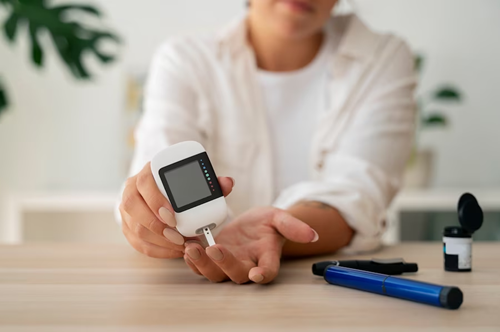Understanding Type 2 Diabetes: Causes, Symptoms, and Treatment Options

What is a Diabetes Chart?
29 Feb 2024
Diabetes is like an infant. You cannot just let it be. If you do, it may go wild and end up with complications. Because diabetes affects how your body deals with blood sugar control, it is important to monitor it and try to stay in the recommended ranges, as indicated in the diabetes chart.
While the blood sugar range recommended for every diabetic person can differ based on multiple factors, let’s look at a generally accepted diabetes chart as recommended by the American Diabetes Association.
Diabetes chart
|
Before meals (fasting) |
After meals (post-prandial) |
Other |
|
|
Adults with type 1 diabetes |
80-130 mg/dL |
< 180 mg/dL (1 or 2 hours after) |
|
|
Adults with type 2 diabetes |
80-130mg/dL |
< 180 mg/dL (1 or 2 hours after) |
|
|
Children with type 1 diabetes |
90-130 mg/dL |
90-150 mg/dL at bedtime/overnight |
|
|
Pregnant people (T1D, gestational diabetes) |
< 95 mg/dL |
140 mg/dL (1 hour after) |
120 mg/dL (2 hours after) |
|
65 or older |
80-180 mg/dL |
80-200 mg/dL for those in poorer health, assisted living, end-of-life |
|
|
Without diabetes |
99 mg/dL or below |
140 mg/dL or below |
What are all these complicated terms?
Well, for starters, all these complicated terms will be your friends in your diabetic journey. Jokes apart, understanding these terms will always come in handy when reading a diabetes chart, let’s dive in:
- Blood Sugar Levels: The amount of glucose in the blood, measured in milligrams per decilitre (mg/dL).
- Fasting Blood Sugar: This is the blood sugar level after not eating for a while, typically overnight.
- Postprandial Blood Sugar: This measures blood sugar levels after eating.
How do I measure my glucose levels?

There are multiple ways to measure your glucose levels. You can choose depending on your convenience and/ or what your doctor suggests.
- Glucometer
A small drop of blood is drawn from your fingertip, placed on a test strip, and then inserted into the glucometer. The results are then displayed on the glucometer screen after some seconds.
- Continuous Glucose Monitoring (CGM)
In this blood sugar test, a sensor is placed on your arm or stomach. The sensor is supposed to be scanned with a reader and can be used for up to 14 days. Many CGM sensors can also be used with a smartphone. The sensor continuously measures glucose levels in the interstitial fluid, providing real-time glucose readings.
Usually, people with diabetes tend to check their glucose levels multiple times a day, which is, before meals and two hours after meals. The readings from these tests will help you determine how your body is performing through a diabetes chart. The frequency of glucose checks can vary based on the individual’s condition and doctor’s advice.
There are other factors too
When consulting a doctor to determine your glucose targets, they may consider multiple factors. These factors are also the reason your glucose targets will always differ from other diabetic people. Several factors influence individual glucose targets, including:
- Your age
- Other health conditions like cardiovascular diseases
- How long you’ve had diabetes
- Pregnancy, if applicable
- Your treatment plan
- History of adverse effects from the treatment
- Any complications from diabetes
- Your lifestyle
- Stress management

What is a daily routine chart?
A daily routinechart is exactly what it sounds like, a plan for your day-to-day life. It mentions the tasks a person with diabetes should include in their every day to manage their condition better. It includes meal organisation, physical activity, blood sugar monitoring, medication doses, etc.
What is a diabetes self-care chart?
A self-care chart is a personalised tool that helps in diabetes management focusing on your overall well-being. It includes a broad range of activities focused on physical, emotional, and mental health. More of what you may see in a self-care chart is:
- Blood Glucose Monitoring
- Medication Adherence
- Meal Planning and Nutrition
- Physical Activity and Exercise
- Stress Management and Relaxation
- Sleep Hygiene
- Self-Monitoring and Goal-Setting
- Social Support and Community Engagement
- Lifestyle Balance and Enjoyment
Some people question why it is even important to measure your blood sugar. But trust us, it is.
Monitoring your glucose levels with the help of a diabetes chart is one of the most important factors in diabetes management. Understanding what causes your sugar spike and fall helps a great deal in developing a customised diabetes care plan and also setting diabetes goals.
Not only that, you get a close-up on how each task affects your sugar levels such as medications, foods, exercise, lifestyle changes etc. In fact, periodically getting your sugar levels checked is a great habit for a non-diabetic person too.
Through the fluctuations of glucose levels, we learn the dance of balance and the art of resilience.
Recent Blog
- AI in Healthcare: Not a Threat, but a Smart Ally
- Your Clinic. Your Website. Your Brand.
- CDSS – Revolutionising Diagnosis with AI-Powered Clinical Decision Support System
- Handwritten to Digital in Seconds: SmartSync Converts Prescriptions Instantly
- Voice Rx by TatvaPractice: A Smarter Way to Digitise Prescriptions
Archives
Categories
- Asthma (20)
- Diabetes (15)
- Fatty Liver (20)
- High Blood Pressure (2)
- High cholesterol (2)
- Hypertension (2)
- Insulin Resistance (1)
- Obesity (8)
- PCOS (6)
- TatvaPractice (13)
Let’s Connect
Quick contact





